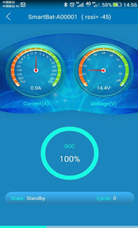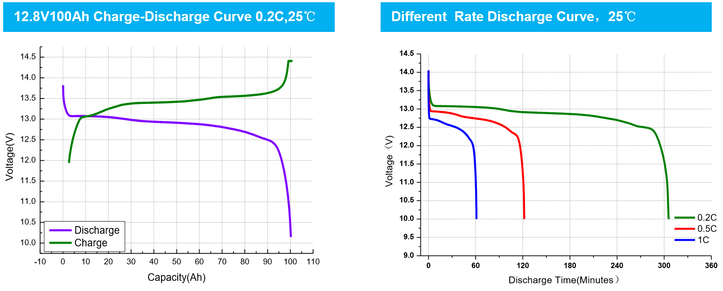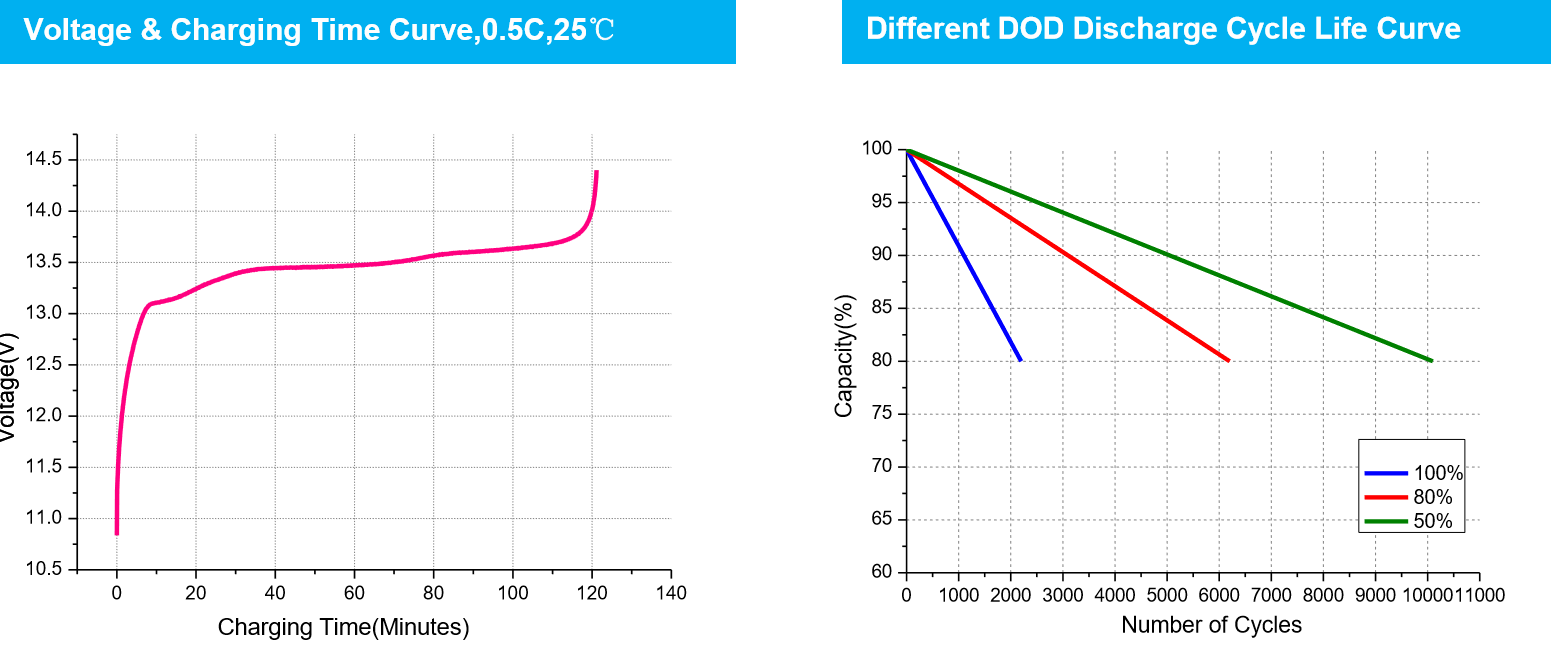Lithium Batteries For Off Grid Use-Bluetooth to your phone for live battery status
-Thousands of cycles vs AGM/lead acid with hundreds - can last a lifetime -Highest max continuous output at 150 amps, competition does not offer this -Roughly Four times the power per pound of lead acid and AGM -> scroll down for purchases <- |
 LiFePO4 Battery Showing Cells and BMS Electronics
LiFePO4 Battery Showing Cells and BMS Electronics
LiFePO4 batteries are the safest type of lithium batteries as they will not overheat, and even if punctured they will not catch fire. The cathode material in LiFePO4 batteries is not hazardous, and thus poses no negative health hazards or environmental hazards. CMPower LiFePO4 batteries are plug compatible with lead acid batteries and will accept a charge from most lead acid configured chargers. The charge voltage and amperage should be within the range specified for the LiFePO4 batteries.
A CMPower LiFePO4 battery has two primary components, the LiFePO cells and the Battery Management System (BMS). Both are housed in a sealed battery case. The quality of each component is key to the longevity and performance of the battery. LiFePO cells are wired in parallel to form a module producing 3.2 volts. Four of these units are connected in series to form a rated 12.8 volt LiFePO4 battery; eight for a 25.6 volt battery. The temperature, charge and discharge of each cell is monitored and managed by the BMS, a computer of sorts built into each battery. In addition to cell monitoring and management, the BMS will prevent over discharging of cells by disconnecting the load and will prevent cell over charging by reducing charge current or stopping the charge process. The BMS will also shut down the system if the battery temperature is out of range.
Our most popular CMPower 12V LiFePO4 battery is rated at 120 Amp hours and is roughly the size of a group 31 lead acid battery. LiFePO4 batteries are also rated as to their maximum discharge capacity; 80 - 100 Amps max discharge capacity is typical. Most CMPower LifePO4 batteries have a discharge capacity of 150 Amps to robustly accommodate both house and start battery power requirements.
LiFePO4 Off Grid Batteries - Product Summary
Charge/discharge cycles - CMPower LifePO4 batteries have an expected life of 2,000-4,000 charge/discharge cycles at a discharge to 90%. Lead acid batteries have an expected life of 300-500 charge/discharge cycles at a discharge to 50%.
Discharge profile - CMPower LifePO4 batteries stay at a voltage of 13 to 13.4 volts during discharge of up to a 95+%. Voltage then drops off rapidly. A lead acid battery decreases in voltage from 13 to below 11.5 volts as more current is drawn. This means many of your appliances will operate more efficiently throughout the discharge cycle using LiFePO4 batteries.
Discharge rate - The BMS built into CMPower batteries has a 100 amp or a 150 amp discharge capacity. This means the batteries can sustain a heavy charge and discharge without damage or degradation. Our manufacturer has advised us that the quality of the cells and quality of the BMS is key to the longevity and performance of a LiFePo4 battery. We've seen this firsthand.
For example, 3 group 31 110 amp hour lead acid batteries weighing a total of 200 pounds can be replaced by 2 group 31 size 100 amp hour LiFePO4 batteries weighing a total of 62 pounds. Both configurations have roughly the same power capacity because the lead acid can be safely drawn down 50% (330 amps @50% = 165 amps) and the Lithium battery can be safely drawn down 95% (200 amps @ 95% = 190 amps). Also, the lead acid will endure 300-500 cycles and the LiFePO4 over 2,000 cycles.
Example: Lead Acid LiFePO4 (Lithium)
Battery Bank 3 Group 31 110 Ah 2 Group 31 size 120 Ah
Rated Capacity 330 Amps 240 Amps
Useable Capacity 165 Amps 216 Amps
Charge/discharge cycles 300-500 2,000-4,000
Weight 200 pounds 62 pounds
Cost $1,200 $2,178 ($1,089 each)
Cost per useable Ah $7.27 $9.08
 Smartphone app for LiFePO4 Battery Monitoring
Smartphone app for LiFePO4 Battery Monitoring
Compatibility - While the optimal charging parameters vary between LiFePO4, AGM and lead acid battery technology, the BMS built into CMPower LiFePO4 batteries compensates for this. Thus, our LiFePO4 boat batteries are compatible with most lead acid battery charging systems.
Bluetooth Battery Monitoring - CMPower LiFePO4 batteries are equipped with Bluetooth for monitoring battery State of Charge (SOC) through a Smartphone or tablet app. This is important because unlike lead acid batteries, LiFePO4 batteries maintain a constant voltage between 13 and 13.4 volts so a voltmeter is not an accurate indicator of SOC. A built in Bluetooth capability enables real time monitoring of each battery through an app on either an Android or IOS smartphone or tablet. The app displays the state of charge (SOC) of the battery, the amp draw and voltage level, the temperature, the time to full charge and the number of charge/discharge cycles. This capability is nearly equivalent to having a built in battery bank monitoring system like a Link 2000.
Winter Operation and Storage - CMPower LiFePO4 batteries can be stored in temperatures from -10°F to +104°F (-25°C to +40°C). It is recommended they not be heavily charged and discharged at temperatures below -4°F (-20°C) . It is recommended that the negative terminals be disconnected during winter or long term storage so there is no chance of draining the batteries while in storage. LiFePO4 batteries should be recharged at a minimum every 6 months while in storage.
Long Term Investment - Keep Them for Life - Because the number of charge cycles of well cared for CMPower LiFePO4 batteries is in excess of 2,000 they can be a long term investment you can take with you from boat to boat or boat to RV. Also, because the batteries have a built in cycle recording system, the batteries can be resold at a value based on their number of charge cycles. For example: The owner of a sailboat purchased three LiFePO4 batteries two years ago; two for house and one for engine starting. After two years of cruising the starting battery had 2 charge cycles and the house batteries, wired in parallel, had only 20 charge cycles as shown on the Bluetooth APP. These batteries are like new and can be taken to their new boat or sold as quality longlife used batteries. In fact, if and when CMP LiFePO4 batteries become available from our customers, we will post them on our website for purchase.
Cost - CMPower LiFePO4 batteries are 2 to 4 times the cost of comparable lead acid or AGM type batteries. Cost justification is often based on convenience, performance and longevity. Factors to consider in evaluating cost include the number of charge cycles, power to weight ratio, charge and discharge efficiency and compatibility. Over the long term, these batteries are often considerably more cost effective than lead acid or AGM batteries.
Bottom line - CMPower LiFePO4 off grid batteries have the following advantages:
1. lighter than lead acid - generally less than half the weight of lead acid
2. can be drawn down 90% vs 50% - more useable capacity
3. hold steady voltage through 95% discharge - constant power and voltage
4. generally plug compatible with lead acid chargers - drop-in replacement
5. charge more quickly and efficiently than lead acid batteries - excellent for solar systems
6. have up to 10 times more charge cycles than lead acid and AGM batteries - could last a lifetime
7. nontoxic and safe, very low fire risk - no toxic gases emitted, many built-in protections
8. low self-discharge - easy winter storage, long shelf life
9. Bluetooth equipped to monitor battery State of Charge with free app - built in battery monitor
10. cost effective in the long run
They are more expensive than lead acid however their advantages and longevity often outweigh the additional initial investment.

This battery measures 13x6.7x8.3 inches 330x170x210 mm.

This 24 V150 Ah LiFePO4 battery is designed for both house and engine start marine applications. It has a built in 120 amp continuous draw Battery Management System (BMS) and is plug compatible with most lead acid and AGM charging systems. A Bluetooth battery monitor system for monitoring the state-of-charge of the battery with a free app is included.
This battery measures 20.5x10.5x8.7 inches 520x267x220mm.
What are the advantages of lithium/LiFePO4 batteries over AGM or lead acid batteries?
LiFePO4 batteries are safe, powerful and plug compatible with most lead acid and AGM battery charging systems. LiFPO4 battery technology offers many advantages over lead acid and AGM technology including high capacity storage, consistently high power at same voltage (meaning higher operating efficiency), much longer cycle life (up to 10x), less weight (half), longer shelf life and rapid efficient charging (20% more efficient), availablity of 95% of rated battery amperage instead of 50-60% available amperage.
What are the major components of a LiFePO4 battery?
A LiFePO4 battery has two primary components, the LiFePO (lithium iron phosphate) cells and the Battery Management System (BMS). Both are inside a sealed battery case. The quality of the cells and BMS are key to the longevity and performance of the battery. LiFePO cells are wired in parallel to form a single module producing 3.2 volts. Four of these modules are connected in series to form a rated 12.8 volt LiFePO4 battery; eight for a 25.6 (24) volt battery. The temperature, charge and discharge of each cell is monitored and actively managed by the BMS, a computer built into each battery. In addition to cell monitoring and management, the BMS will prevent over-discharging of cells by disconnecting the load and will prevent cell over-charging by reducing charge current or stopping the charge process. The BMS will also shut down the system if the battery temperature is out of range and wait for it to come down before continuing to charge.
Home Page Solar Panels Mounting Kits Product Page Marine Solar Systems Gallery of Installations Customer Comments Contact Us
Call 248 705-8337 or email [email protected]
Article On How To Size Your Solar Panels For Your Boat
Customer Reviews Return Policy Privacy Policy Shipping Times/Rates













